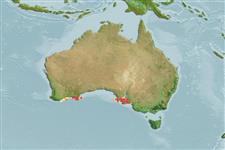Environment: milieu / climate zone / depth range / distribution range
Ecologia
marinhas associadas(os) a recifes; intervalo de profundidade 0 - 10 m (Ref. 57886). Temperate; 34°S - 36°S (Ref. 57886)
Eastern Indian Ocean: Australia.
Tamanho / Peso / Idade
Maturity: Lm ? range ? - ? cm
Max length : 11.5 cm TL macho/indeterminado; (Ref. 33839); 10.3 cm SL (female)
Descrição breve
Morfologia | Morfometria
Raios dorsais moles (total): 97-112; Raios anais moles: 57 - 64; Vértebras: 52 - 57. The species is distinguished by having a very elongate body; vertebrae 19-22 + 33-36 = 52-57,
dorsal fin rays 97-112, anal fin rays 57-64, D/A 42-51, V/A 23-26; body with scales; supraorbital pore behind eye present; lower preopercular pores 3, the 2 first tubular; posterior infraorbital pores 3; broad angle on ventral maxilla positioned behind rear of eye; exposed opercular
spine bent upwards; lower lip with skin folds; single pair of pseudoclaspers curved, hockey stick-like, thin; penis slightly shorter than pseudoclaspers, with hook at tip; otoliths rounded anteriorly and expanded posteriorly, without postdorsal angle, otolith length to height ratio
2.3-2.4, sulcus wide (Ref. 57886).
A locally abundant, secretive species inhabiting inshore reefs (Ref. 34024). A female specimen ( 77 mm TL) was reported by McCulloch and Waite (1918) to contain three fully developed embryos, 28 mm in total length. Coloration is reported to include dark pigmentation dorsally. Specimens are also commonly found with copepod remains in the stomach (seen from x-rays). Maximum length for female is 103 mm SL (Ref. 57886).
Life cycle and mating behavior
Maturidade | Reprodução | Desova | Ovos | Fecundidade | Larvas
Møller, P.R. and W. Schwarzhans, 2006. Review of the Dinematichthyini (Teleostei, Bythitidae) of the Indo-west Pacific, Part II. Dermatopsis, Dermatopsoides and Dipulus with description of six new species. The Beagle 22:39-76. (Ref. 57886)
Categoria na Lista Vermelha da IUCN (Ref. 130435)
Ameaça para o homem
Harmless
Utilização humana
Pescarias: sem interesse
Mais informação
Nomes comunsSinónimosMetabolismoPredadoresEcotoxicologiaReproduçãoMaturidadeDesovaAgregação para desovaFecundidadeOvosDesenvolvimento dos ovos
Idade/TamanhoCrescimentoComprimento-pesoComprimento-comprimentoFrequência de comprimentoMorfometriaMorfologiaLarvasDinâmica larvarRecrutamentoAbundânciaBRUVS
ReferênciasAquaculturaPerfil para aquaculturaEstirpesGenéticaElectrophoresesHereditariedadeDoençasProcessamentoNutrientsMass conversion
ColaboradoresFotografiasStamps, Coins Misc.SonsCiguateraVelocidadeTipo de nataçãoÁrea branquialOutras referênciasCérebrosVisão
Ferramentas
Relatórios especiais
Descarregue XML
Fontes da internet
Estimates based on models
Preferred temperature (Ref.
123201): 16.8 - 18.3, mean 17.2 °C (based on 51 cells).
Phylogenetic diversity index (Ref.
82804): PD
50 = 0.5312 [Uniqueness, from 0.5 = low to 2.0 = high].
Bayesian length-weight: a=0.00389 (0.00180 - 0.00842), b=3.12 (2.94 - 3.30), in cm total length, based on all LWR estimates for this body shape (Ref.
93245).
Nível Trófico (Ref.
69278): 3.4 ±0.5 se; based on size and trophs of closest relatives
Resiliência (Ref.
120179): Baixo, tempo mínimo de duplicação da população 4,5 - 14 anos (Assuming Fec < 100).
Fishing Vulnerability (Ref.
59153): Low vulnerability (10 of 100).
